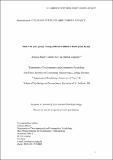Files in this item
Stick with your group : young children's attitudes about group loyalty
Item metadata
| dc.contributor.author | Misch, Antonia | |
| dc.contributor.author | Over, Harriet | |
| dc.contributor.author | Carpenter, Malinda | |
| dc.date.accessioned | 2016-03-09T15:10:03Z | |
| dc.date.available | 2016-03-09T15:10:03Z | |
| dc.date.issued | 2014-10 | |
| dc.identifier | 99380387 | |
| dc.identifier | b0dbcc32-6420-4462-a36d-907bef0779dd | |
| dc.identifier | 84900808318 | |
| dc.identifier | 000340219300002 | |
| dc.identifier.citation | Misch , A , Over , H & Carpenter , M 2014 , ' Stick with your group : young children's attitudes about group loyalty ' , Journal of Experimental Child Psychology , vol. 126 , pp. 19-36 . https://doi.org/10.1016/j.jecp.2014.02.008 | en |
| dc.identifier.issn | 0022-0965 | |
| dc.identifier.other | ORCID: /0000-0003-3983-2034/work/64698039 | |
| dc.identifier.uri | https://hdl.handle.net/10023/8391 | |
| dc.description | Harriet Over was supported by the Economic and Social Research Council (Grant ES/K006702/1). | en |
| dc.description.abstract | For adults, loyalty to the group is highly valued, yet little is known about how children evaluate loyalty. We investigated children’s attitudes about loyalty in a third-party context. In the first experiment, 4- and 5-year-olds watched a video of two groups competing. Two members of the losing group then spoke. The disloyal individual said she wanted to win and therefore would join the other group. The loyal individual said she also wanted to win but would stay with her group. Children were then asked five forced-choice questions about these two individuals’ niceness, trustworthiness, morality, and deservingness of a reward. The 5-year-olds preferred the loyal person across all questions; results for the 4-year-olds were considerably weaker but in the same direction. The second experiment investigated the direction of the effect in 5-year-olds. In this experiment, children answered questions about either a loyal individual, a disloyal individual, or a neutral individual. Children rated both the loyal and neutral individuals more positively than the disloyal individual across a number of measures. Thus, whereas disloyal behavior is evaluated unfavorably by children, loyal behavior is the expected norm. These results suggest that, at least from 5 years of age, children understand that belonging to a group entails certain commitments. This marks an important step in their own ability to negotiate belonging and become trustworthy and reliable members of their social groups. | |
| dc.format.extent | 1107486 | |
| dc.language.iso | eng | |
| dc.relation.ispartof | Journal of Experimental Child Psychology | en |
| dc.subject | Loyalty | en |
| dc.subject | Group membership | en |
| dc.subject | Group norms | en |
| dc.subject | Social–cognitive development | en |
| dc.subject | Morality | en |
| dc.subject | Trust | en |
| dc.subject | BF Psychology | en |
| dc.subject | BDC | en |
| dc.subject | R2C | en |
| dc.subject.lcc | BF | en |
| dc.title | Stick with your group : young children's attitudes about group loyalty | en |
| dc.type | Journal article | en |
| dc.contributor.institution | University of St Andrews. School of Psychology and Neuroscience | en |
| dc.contributor.institution | University of St Andrews. Centre for Social Learning & Cognitive Evolution | en |
| dc.identifier.doi | https://doi.org/10.1016/j.jecp.2014.02.008 | |
| dc.description.status | Peer reviewed | en |
This item appears in the following Collection(s)
Items in the St Andrews Research Repository are protected by copyright, with all rights reserved, unless otherwise indicated.

